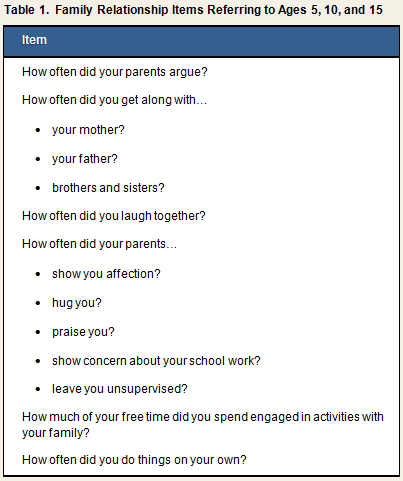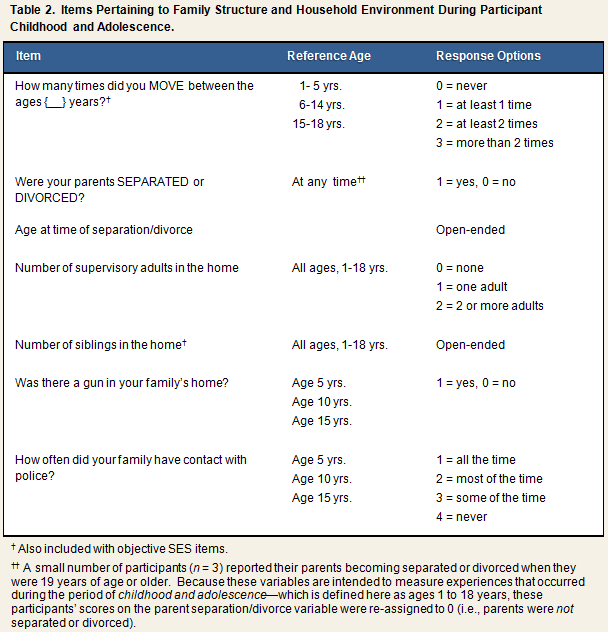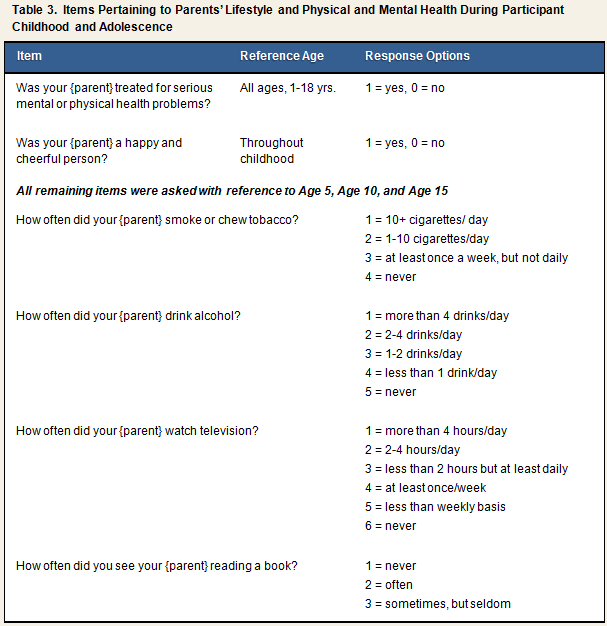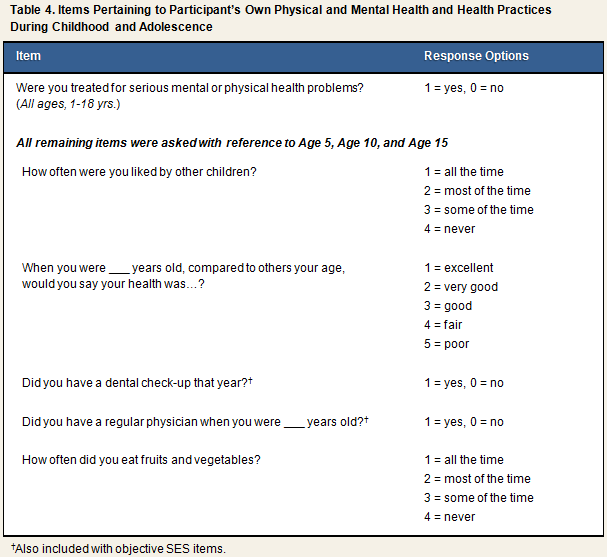Childhood Experiences
Title
Study
PCS3
Copyright Information
Not a copyrighted scale
Primary Reference
Cohen, S. (2010). SC Childhood Interview. Retrieved from http://www.psy.cmu.edu/~scohen/.
Purpose
To obtain a comprehensive assessment of participants’ overall childhood and adolescent experience with regard to the specific domains of objective and subjective socioeconomic status, family environment and relationships, parents’ physical and psychological health and health practices, and participants’ own physical and psychological health as children and adolescents.
Description
The Childhood Interview (CI) is presented as a battery of self-report questionnaires of varying format. The first section asks participants to respond to each item in reference to every year of their childhood/adolescence between ages 1 and 18 years. The second section is comprised of 3 identical questionnaires, which differ only in the period during childhood to which the items refer. Specifically, the first questionnaire focuses on age 5, the second on age 10, and the third on age 15. The third section contains items that refer to childhood/adolescence more generally. Although participants were encouraged to try to provide as much information as possible, they were, for most items, provided with the option of responding that they are not sure how best to answer. Providing this option allowed us to differentiate “no answer” from true missing data. In PCS3, the CI was presented on Quarantine Day 0.
Number of Items
See below
Psychometrics
Not available
Scoring/Variables
We have not established any specific algorithms for scoring the CI. We do, however, provide references to examples of childhood socioeconomic status indices that have been derived from interview items (Carroll et al., 2011; Horenstein, J.A., 2008).
Items comprising the CI are described below. We have grouped the items based on their conceptual similarity rather than how they are presented in the interview itself. This organization is for presentational purposes only. We have not yet performed sufficient analyses on the CI items to determine whether questions with face-value similarity actually do reflect the same construct, and thus can be combined into a single psychometrically valid measure.
Childhood Socioeconomic Status
- Objective measures (see Childhood Socioeconomic Status)
- Subjective measures (see Childhood Subjective Social Status)
Family Relationships
Table 1 displays items pertaining to family relationships. All items were asked with specific reference to age 5, age 10, and age 15. Participants responded to each item using a 4-point frequency scale:
1 = all the time, 2 = most of the time, 3 = some of the time, 4 = never.
Participants also had the options of indicating that they were not sure how to respond, and in the case of specific family relationships, that they lived apart from that person and never spoke with him or her.
Total family relationship items: 14 per reference age (42 total)

Family/Household Environment
Table 2 displays items pertaining to family structure and household environment during childhood and adolescence. As indicated by the second column of Table 2, items differed in regard to the period(s) during childhood and adolescence to which they referred. Accordingly, whereas some items were presented multiple times (e.g., number of siblings in the home was reported for each year between ages 1 and 18 years), others were presented only once (e.g., Were your parents separated or divorced?).
Total family/household environment items: 2 + 5 per reference age (47 total)

Parents’ Lifestyle and Physical and Mental Health
Table 3 displays items that refer to the mental and physical health of participants’ mothers and fathers when the participants were children/adolescents, as well as several items pertaining to parental lifestyle and health behaviors. Each item was asked separately for each parent.
Total parents’ lifestyle and physical/mental health items: (1 + 5 per reference age) x 2 parents (62 total)

Participant Physical and Mental Health and Health Practices During Childhood
Table 4 displays items related to participants’ own mental and physical health and well-being when they were children/adolescents. The table also contains items referring to health-related behaviors and health care. With the exception of the item asking about treatment for mental or physical health problems, all items were asked with reference to age 5, age 10, and age 15.
Total childhood physical/mental health and health practice items: 6 per reference age (33 total)

Additional References
1. Carroll, J. E., Cohen, S., & Marsland, A. L. (2011). Early childhood socioeconomic status is associated with circulating interleukin-6 among mid-life adults. Brain, Behavior and Immunity, 25, 1468-1474.
2. Crittenden, C. N., Carroll, J., Cohen, S., & Marsland, A. L. Early life socioeconomic status and diurnal cortisol among mid-life adults: Adolescence as a critical period for HPA programming.
3. Horenstein, J. A. (2008). Childhood socioeconomic status and depressed affect. (Unpublished Doctoral Dissertation). Carnegie Mellon University, Pittsburgh, PA.